Below is a brief introduction to the Life Stages Film Forum. We request that discussion group leaders read the introduction aloud at the first class meeting. Following the introduction, you will find a short inspirational passage for participants to read titled “How To Think About Art.” Finally, you will find discussion questions for each movie. Students can follow along on their phones at: www.extraordinarymovies.org.
Direct students to click on “Menu” at the top of our homepage and to then click on “Curriculum” in the pull-down menu for “Film Forum.”
Introduction
If someone asked me to sum up the Life Stages Film Forum in two words, those words would be ‘passionate awareness’.
—Thomas J. Lowry III, Founder Life Stages Film Forum
The Life Stages Film Forum is about life as it is interpreted by movies. We will be watching and discussing some of the great classics of world cinema. Just as there is a canon of great books, we believe there is also a canon of great movies. We will be watching and discussing these extraordinary movies together in order to create something like a shared world. These days, most of us inhabit a personalized digital universe, so this shared world may feel unfamiliar at first.
As you watch the movies, you will see that people from all over the world are facing the very same problems you are facing. Just like the characters in the movies each of us has a unique point of view. We face different challenges and we have different abilities, different opportunities, different hopes, and different dreams. For this reason, your interpretation of the movies will likely differ somewhat from the interpretations of the other participants.
We believe that great movies can change lives. As you watch these movies, our hope is that you will become more aware, more understanding, more at peace, and more loving. All it takes is one great movie to change a person’s life forever!
How To Think About Art
In his masterpiece In Search of Lost Time, Marcel Proust explains why we need art in order to live full, rich lives:
Our vanity, our passions, our spirit of imitation, our abstract intelligence, our habits have long been at work, and it is the task of art to undo this work of theirs, making us travel back in the direction from which we have come to the depths where what has really existed lies unknown within us.
The author Franz Kafka’s ideal of what a book should be:
An ax for the frozen sea within us.
The writer Kurt Vonnegut was teaching a class at a university. In an assignment which involved ranking and comparing different short stories he instructed his students as follows:
I want you to adore the universe, to be easily delighted, but to be prompt as well with impatience for those artists who offend your own deep notions of what the universe is or could be. Do so as a sensitive person who has a few practical hunches about how art can succeed or fail. Praise or damn as you please, but do so rather flatly, pragmatically, with cunning attention to annoying or gratifying details.
Wings of Desire (1987)
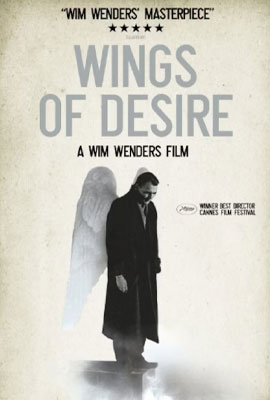
directed by Wim Wenders
- Wings of Desire has been described as a “city symphony.” The film’s original title was “The Sky or Heavens Over Berlin.” The angels were an inspired afterthought. How does the city contribute to the aesthetics of the film? How does the city contribute to the film’s theme of alienation?
- What qualities do the angels in Wings of Desire have that human beings don’t have?
- What qualities do the human beings in Wings of Desire have that angels don’t have?
- What special qualities does the trapeze artist have that cause the angel Damiel to fall in love with her? Is the trapeze artist different from other human beings?
- Which scenes in the movie did you find most moving?
- Which of the following quotations do you think best captures the central message of the film? (Neither quotation has anything to do with Wings of Desire or with movies in general.)
Listen to your life. See it for the fathomless mystery that it is. In the boredom and pain of it no less than the excitement and gladness: touch, taste, smell your way to the holy and hidden heart of it because in the last analysis all moments are key moments, and life itself is grace. —Frederick Buechner
Love every leaf, every ray of God’s light. Love the animals, love the plants, love everything. If you love everything, you will perceive the divine mystery in things. —Fyodor Dostoyevsky
Pather Panchali (1955)
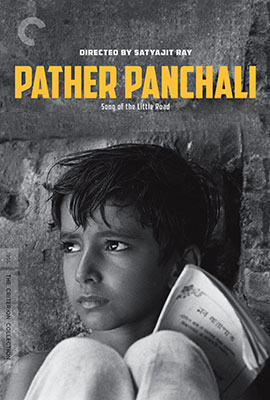
directed by Satyagit Ray
Pather Panchali is the kind of cinema that flows with the serenity and nobility of a big river. —Akira Kurosawa
- In contrast to Apu’s always worried mother, Apu’s father is largely hopeful, believing that things will turn out for the best, and believing that God has a plan. How does his perspective affect the family?
- How is the elderly auntie treated by members of the family? What larger statement is made regarding the plight of elderly women in Indian society?
- Objects in the film, including the stolen fruit, the rice container with its slowly diminishing contents, the wedding gifts Apu’s mother is forced to sell, Auntie’s new shawl, the stolen necklace, and Durga’s treasure box ground the human drama in the material world. These objects give exquisite meaning to Ray’s film. Explain how these rather ordinary objects become so emotionally charged over the course of the film. Do you have objects in your own life which harbor special meanings and convey strong emotions?
- What do the images of the natural world contribute to the meaning of the film?
- What is the significance of water in Pather Panchali?
- Pather Panchali has been criticized for romanticizing poverty. Do you agree or disagree?
Aparajito (1956)
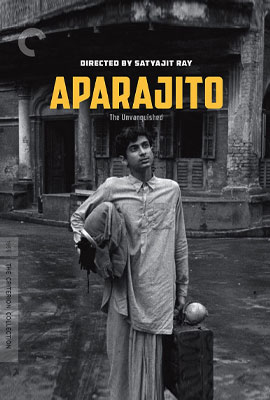
directed by Satyagit Ray
- In Aparajito, the family moves from a remote village to a bustling city. How does life in the city change each family member’s opportunities and expectations?
- What new challenges are introduced by city life?
- How do the images of the natural world in Aparajito differ from the images of the natural world in Pather Panchali?
- What is the significance of water in Aparajito?
- How does the coming of age experience in Aparajito differ from our typical present day coming of age experiences?
- Aparajito is about the generosity that’s required for a parent to let go of a beloved child, which is something all parents have to do if they care about their children’s happiness. What are your thoughts regarding the scene in which Apu’s mother slaps him? What are your thoughts regarding the aftermath of this scene?
Apur Sansar (1959)
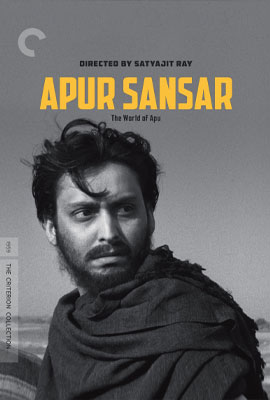
directed by Satyagit Ray
- At the beginning of Apur Sansar, Apu awakens to the sound of a train passing nearby. Trains are a common theme in all three movies. Do the trains have different meanings in each film? Do the trains have meanings in common across all three films? Are there any other images that tie all three films together?
- Early in the movie, Apu is searching for a job. He is overqualified for the jobs that are available. Today, across the developing world, youth unemployment continues to be an intractable problem. Obviously, considering the visible poverty, there is plenty of unmet demand for goods and services. Why is youth unemployment, even among those with a good education, such a difficult problem to solve? Can you think of any solutions?
- On the way to the wedding, Apu and Pulu travel along a river in a primitive river boat. The river scenes are breathtakingly beautiful. Towards the end of the movie, Apu stands staring at the waves breaking on a vast, lonely seashore. What is the meaning of water in Apur Sansar?
- Do you have any theories why Apu finally agreed to marry Aparna?
- When Aparna, the young bride, sees her new home, she begins crying. In the courtyard below, a playful toddler is laughing. The toddler’s laughter seems to comfort Aparna. Why does the sound of the child’s laughter comfort Aparna?
- Did the movie change your attitude towards arranged marriages?
Tokyo Story (1953)
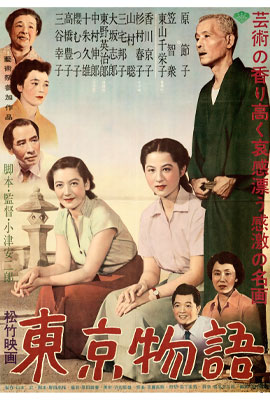
directed by Yasujiro Ozu
- What are some of the ways that social interactions in Ozu’s film differ from social interactions in contemporary America?
- Do you think everyday life in America is as busy as everyday life in Ozu’s film? Would you find it difficult to accommodate a week-long visit by your grandparents, assuming they are still alive?
- What are your thoughts regarding the grandparent’s vacation to Atami Hot Springs?
- Which scenes in the movie did you find most moving?
- Ozu separates the scenes in the film with evocative images from everyday life. He films trains, rising smoke, empty streets, clothes hanging on a line, and banners blowing in the wind. Ozu called these “pillow shots.” In Japanese poetry, the “pillow words” serve to pause and comment on a poem. Did these “pillow shots” speak to you? If so, what did the shots of clothes hanging on a line say to you? How about the passing trains?
- Towards the end of the film, the youngest daughter is distraught at the selfishness displayed by her brothers and sisters. Noriko tries to comfort her by explaining and to some extent justifying their behavior. Did you find Noriko’s explanations convincing?
The 400 Blows (1959)
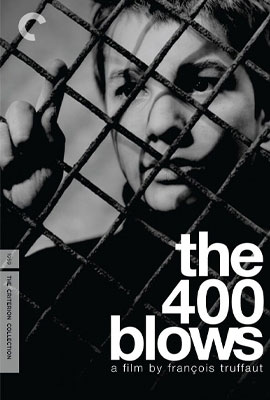
directed by Francois Truffaut
- The 400 Blows has a distinctive musical theme that plays at crucial points throughout the movie. What role does music play in the film?
- Based on what you saw in the film, what is your impression of the juvenile justice system in France at that time?
- There are a number of scenes in the movie which are not directly related to the plot. These include the scene in which the physical education teacher takes a class for a run and the scene in which the children attend a puppet show. Do these scenes serve a function similar to the “pillow shots” in Ozu’s film Tokyo Story or do they serve some other purpose?
- Did anything in the movie remind you of events in your own childhood? For example, did you ever forge a parent’s signature explaining a school absence? Were you constantly running?
- Which scenes in the movie did you find most moving?
- What does the ocean represent in the famous last scene of the movie?
Frances Ha (2012)
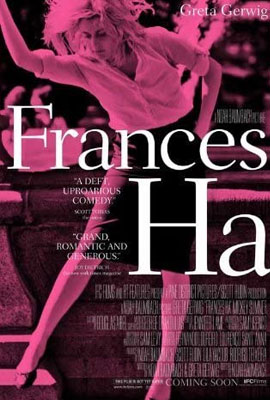
directed by Noah Baumbach
- How do you feel about movies that reference other movies? In The 400 Blows, for example, Antoine’s stare directly into the camera at the end of the movie echoes Monika’s long stare into the camera towards the end of Ingmar Bergman’s Summer With Monika. Godard and Truffaut were both transfixed by Monika’s defiant gaze and this shot inspired the closing shots of both FrancoisTruffaut’s “The 400 Blows” and Jean-Luc Godard’s “Breathless.” Frances Ha, with its black and white cinematography and its youthful attitude, pays homage to the French New Wave. Do you think references of this sort add to a movie’s impact?
- How would you describe Frances and Sophie’s friendship?
- What exactly does it mean to be “undateable?”
- In Frances Ha, there is a focus on places: Brooklyn, Tribeca, Sacramento, Paris, Japan, Poughkeepsie. We follow Frances and Sophie as they bounce from place to place. Do you think not having a secure place in the world is typical of the coming of age experience or unique to Frances Ha? How about money? When Frances’ debit card is declined she says, “I am not a real person yet.” If you met a fifty-year-old person who rented their apartment, was single, was not financially secure, and who lacked self awareness, would you describe that person as not having “come of age”?
- Frances and Sophie are very competitive. Frances tells everyone at a dinner party, for example, that Sophie doesn’t read except for work and that she reads more. At one point in the movie Sophie admits that she has always been very competitive with Frances. Do you think their competitiveness dooms their friendship?
- The film’s title, “Frances Ha,” is brilliant. It has an insouciant, self-deprecating quality that seems a perfect fit for the Frances we have come to know over the course of the film. How important do you think a film’s title is to its success?
In the Mood for Love (2000)
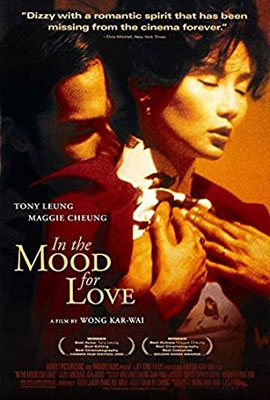
directed by Wong Kar-Wai
- With its aching soundtrack and its exquisite cinematography, many consider In the Mood for Love to bethe most beautiful movie ever made. Do you agree or disagree? Do you think the soundtrack and cinematography should subtly serve the story or does it meet with your approval when the soundtrack and cinematography play a more prominent role in the movie?
- Rich, lush colors convey the mystery of falling in love. Deep dark reds, golden yellows, and shadowy blacks saturate the film. Do you associate falling in love with particular colors, particular pieces of music, particular places, or particular seasons?
- Wong famously filmed the couple in a love scene. During the editing process, however, he decided not to use it in the film. Do you think he made the right decision?
- Many key moments in the film occur in restaurants and noodle shops. The characters are often eating while in conversation. Do you think food facilitates conversation? Do you think food is a crucial element in creating romantic bonds?
- Which part of the story told by the movie was most powerful? Why?
- What were you thinking as you watched the ending of the movie?
Lolita (1962)

directed by Stanley Kubrick
- Was Quilty’s earlier affair with Lolita in any way more blameworthy than Humbert’s affair with Lolita?
- When Humbert shoots Clare Quilty, the shots pass through a Gainsborough painting of a young woman. Presumably, the painting of the young woman represents Lolita. Is Clare Quilty somehow responsible for spiritually “killing” Lolita?
- Does Humbert’s deep love for Lolita, as revealed by his tearful departure towards the end of the movie, in any way excuse his behavior?
- The actress who plays Lolita, Sue Lyon, was fourteen at the time of filming. The actress who plays Aparna in Satyagit Ray’s glorious Apur Sansar was also fourteen at the time of filming. Different cultures have different laws regarding the age of consent. Should these differences be respected or condemned? Does it change your views if life expectancies are much lower in the country with a lower age of consent?
- Quilty’s bizarre behavior, his awkward friendliness, and, above all, his repeated appearances suggest that Quilty personifies Humbert’s guilt stricken alter ego. Do you agree or disagree with this analysis?
- Towards the end of the movie, Lolita expresses regret for her behavior. Do you think Lolita is in any way culpable?
Summer With Monika (1953)
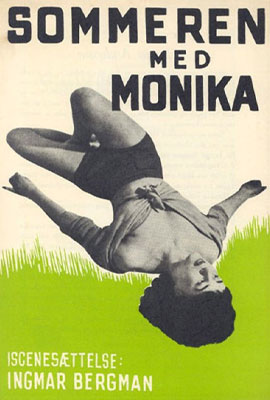
directed by Ingmar Bergman
- Bergman returns to the images and sounds of clocks again and again in his films. At the beginning of the movie, the chiming of city clocks marks the moment of the lovers’ departure. What emotion did the sound of the clocks convey at the beginning of the movie? Do you recall being affected by the sound of the clocks at this point in the movie?
- The lovers’ heartbroken return to the city is also marked by the sound of clocks. Do you recall being affected by the sound of the clocks at this point in the movie? What emotion did the sound of clocks convey at this point in the movie?
- The director Jean-Luc Godard, discussing “Summer With Monika,” said that Bergman’s camera “seeks only one thing, to seize the present moment at its most fugitive and delve deep into it to give it the quality of eternity.” The nature scenes in Summer With Monika include open spaces surrounded by water, tall seaside grasses, and rain drops disturbing the surface of a still pond. All these shots were taken in the present. How, exactly, do they suggest “the quality of eternity”?
- Once Monika becomes pregnant, the heavy weight of responsibility bears down on the young lovers. Harry wants to complete his education, find a good job, and enjoy the good life with his wife and child. Monika sees Harry’s striving as just another trap and refuses to go along with his plans. Her decision to opt instead for an immediately available, less emotionally demanding man suggests that betrayal by the woman is inevitable when an earthy, spontaneous woman is matched with an emotionally sensitive, intellectual man. Do you agree or disagree?
- Monika’s long stare into the camera expresses the primacy of the human face. To what extent do you think cinema in general is about “the primacy of the human face”?
- If you had a chance to ask a character in this movie a question, what would it be?
La Strada (1954)
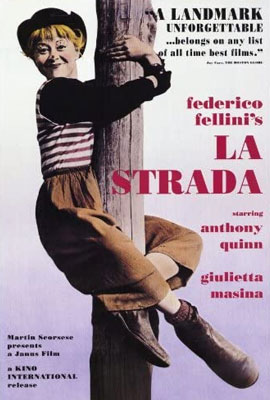
directed by Federico Fellini
- Pope Francis has said that “La Strada” is his favorite movie. Does learning this affect your opinion of La Strada? Do you attach much importance to movie reviews in general?
- Fellini turns again and again in his films to the image of a figure suspended between earth and sky. In “La Strada,” the Fool is that figure. Fellini would rework this image until the end of his life. What do you think Fellini is trying to express with the image of a figure suspended between earth and sky?
- Gelsomina imagines a life with the Fool away from the hardships of her life with Zampano but the Fool convinces her to stay with Zampano, despite his selfish brutality, because, “Everything serves a purpose, even the stones.” Do you think the Fool says this because Gelsomina is mentally handicapped and therefore is not someone the Fool would consider having a relationship with? Do you think Gelsomina’s mental handicap makes her better or worse than other human beings?
- If a psychologist were to look at the actions of Zampano, what do you think the psychologist would say about that character?
- What were your thoughts when Zampano abandons Gelsomina high in the snow covered mountains?
- Depth of feeling is what makes a film worth watching. Of the many feelings expressed in this film, with which are you most familiar?
Dersu Uzala (1975)

directed by Akira Kurosawa
He looks old and it is a sorry sight to see him solitary after so many years, so many days and nights unthinkingly given to that rumor rising at birth and even earlier. What shall I do? What shall I do? Now low, a murmur, now precise as the headwaiter’s. And to follow? And often rising to a scream. And in the end, or almost, to be abroad alone, by unknown ways, in the gathering night, with a stick.
—Samuel Beckett “Molloy”
- When Dersu happens upon a group of Russian military surveyors, an unlikely friendship develops. Why do you think the friendship developed?
- The astonishing scene in which Dersu is forced to kill a Siberian tiger is breathtakingly beautiful. Later, the cinematographer uses an eerie red filter to capture the image of a vengeful spirit tiger. Did you think the use of a red filter was effective?
- Which character in the film do you admire the most? What was it about that character that caused you to have that reaction?
- What was the strongest emotion you felt while watching the film?
- In what ways is Dersu Uzala similar to a classic American Western?
- Dersu Uzala is included on the Vatican’s list of forty-five great films under the “Values” category, compiled in 1995 upon the 100th anniversary of cinema. What values do you think are most prominent in Dersu Uzala?
Hiroshima mon amour (1959)

directed by Alain Resnais
- Parts of Hiroshima mon amour were shot in the actual city of Hiroshima. Hiroshima has been completely rebuilt only fifteen years after the city was destroyed by an atomic bomb. Tourists are visiting ground zero. Were you surprised that the city could be rebuilt so soon after being destroyed?
- “In my film, time is shattered,” Resnais said. In “Hiroshima mon amour,” the storytelling is circular and inconclusive. Past, present, and future are entwined. Why do you think Resnais chose this way of presenting his film?
- The film’s final lines suggest a story with no end. “Hiroshima. That’s your name,” she tells him. He replies, “It’s my name. Yes. Your name is Nevers. Nevers, a city in France.” Each character is forever located in the place from which they came. Would you describe yourself as being permanently connected to a particular place?
- Subconscious motives are often the most powerful causes of human behavior. Are there any major characters in Hiroshima mon amour who act on motives of which they are not aware? Describe any unconscious motives of the major characters and explain how these motives affect the actions of those characters.
- One way to examine plot is to determine what type of conflict it entails. The classic divisions are: (1) person vs. person; (2) person vs. society, (3) person vs. nature, and (4) person vs. self. Often, more than one of these types of conflict occurs in a story. Using this analysis, briefly describe the conflicts in this story and classify them according to the categories set out above.
- Often the central problem in a story transcends the characters. The persons in the story are simply the tools used to resolve the problem. In this story, is there a problem that transcends the characters and how is it manifested?
The Cranes are Flying (1957)
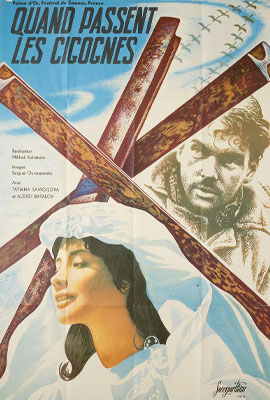
directed by Mikhail Kalatozov
- The Cranes Are Flying tells its story in part through its cinematic virtuosity. The director, Mikhail Kalatozov, deploys what he calls an “emotional camera,” his term for the elaborate handheld takes that express his characters’ feelings in purely visual terms. Did you think the handheld takes were effective?
- In all of the film’s most emotionally charged scenes, when Veronica rushes to her parents’ apartment only to discover that it no longer exists, when she flees from Mark’s advances, and when she runs to the railway bridge in order to throw herself off, the camera stays close by her side. The camera invites the viewer to be both physically “by her side” and emotionally “on her side.” Which of these scenes affected you the most?
- What are the personal qualities that help Veronica survive and grow in the film?
- What part of the story told by the film was most powerful?
- What did you like best about the movie? Why?
- What were you thinking at the end of the movie when Veronica distributes the flowers she had intended for Boris to the crowd? If you were writing the screenplay for this movie, would you have changed the ending? Explain your answer.